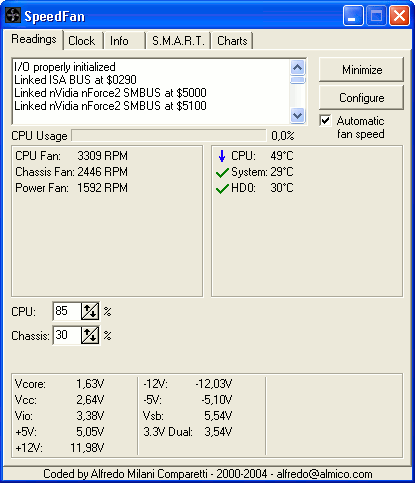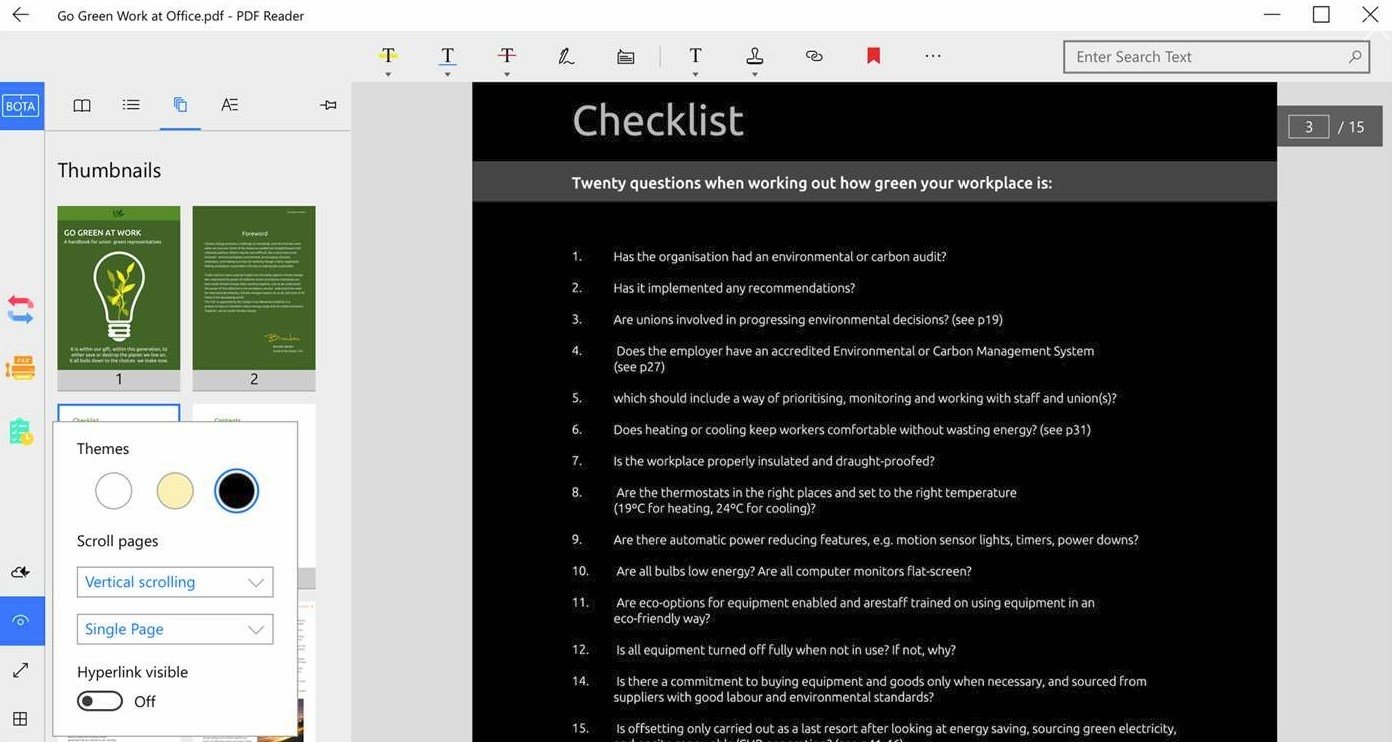17-09-2021
Speedfan Portable Free Download

Almico Speedfan Download


SpeedFan portable is a free system monitoring software for Microsoft Windows, which is able to read various computer specifications, voltages and temperatures of various computer components. It is able to alter computer fan speeds based on the temperature of different components. Speedfan Portable Free Download. 11/7/2018 0 Comments SpeedFan Download Overview Hardcore PC users are always in search of a simple and effective software which keep. It’s is a free system monitoring program built for advance users. Speedfan helps you stay on top of your system’s vital statistics and enables users to troubleshoot issues.
If you need a tool that can change your computer's fan speeds, read the temperatures of your motherboard and your hard disk, read voltages and fan speeds and check the status of your hard disk using S.M.A.R.T. or SCSI attributes, then you came to the right place. SpeedFan is the software to go. It is fully configurable and you can create custom events to handle every situation automatically. SpeedFan works under Windows 9x, ME, NT, 2000, 2003, XP, Vista, Windows 7, Windows 8, Windows 10. SpeedFan works under Windows Server 2003, Windows Server 2008 and Windows Server 2012 too. SpeedFan works fine on 64 bit too. The relevant driver is now signed with my digital certificate. And this all costs you absolutely nothing! | |
| |
SpeedFan lets you take a deeper view at the status of your computer. Almost every computer includes support for hardware monitoring. Accessing digital temperature sensors is really useful. If you are trying to figure out why your PC hangs when under heavy load or after some hours of usage, SpeedFan might help you find the real cause. Very often it is a poor power supply, or an improperly installed heatsink that lead to behaviours that we tend to associate (incorrectly) with errors from the operating system. SpeedFan automatically searches your computer for informative chips: the hardware monitor chips. SpeedFan can display voltages, fan speeds and temperatures. On rare occasions, the BIOS doesn't activate such features. SpeedFan tries to enable them as long as this is a safe thing to do. Not only the motherboard is searched, but also some video cards and almost every currently sold hard disk. SpeedFan can access status info from EIDE, SATA and even SCSI drives, consistently showing internal data that can be used to diagnose current and future hard disk failures. This is known as S.M.A.R.T. (Self-Monitoring Analysis and Reporting Technology). At the lowest level, the SpeedFan hardware monitor software can access digital temperature sensors, but its main feature is its ability to control fan speeds according to the temperatures inside your PC, thus reducing noise. | |
SpeedFan is an extremely powerful tool. It can be very useful in helping you find the reasons for an unpredictable reboot or a failing hard disk. It can tell you whether you are likely to experience temperature related issues and can help you to greatly reduce the noise at work or while watching a movie. But this great power requires access to a lot of resources on your motherboard and it might be that your hardware does not like such kind of access. SpeedFan is used worldwide since 2000 and there are so many happy users out there, but you should always remember that no program can be perfect and therefore I can't be held responsible if SpeedFan causes any damage to your system. |
Speedfan Portable Free Download
SpeedFan is a program that monitors voltages, fan speeds and temperatures in computers with hardware monitor chips. SpeedFan can even access S.M.A.R.T. info and show hard disk temperatures. SpeedFan supports SCSI disks too. SpeedFan can even change the FSB on some hardware (but this should be considered a bonus feature). SpeedFan can access digital temperature sensors and can change fan speeds accordingly, thus reducing noise. SpeedFan works fine with Windows 9x, ME, NT, 2000, 2003, XP, Vista, Windows 7, 2008, Windows 8 and Windows Server 2012. It works with Windows 64 bit too.
SpeedFan 4.51 Final is now online! It adds support for a lot of new hardware. This version defaults to no SCSI access if the Intel Storage Driver is found. ITE IT8620E (used on several Gigabyte boards) support has been greatly enhanced (now SpeedFan can control up to 5 fans and report voltages too). PWM4 and PWM5 on ITE IT8620E are now disabled by default (please, read this article). Added full support for Windows 10. Bug fixes and more, as always.
How fan speed changing works
SpeedFan monitor temperatures from several sources. By properly configuring SpeedFan, you can let it change fan speeds based on system temperatures. When choosing parameters for the minimum and maximum fan speed, try to set them by hand (disable all the VARIATE FANs checkboxes) and listen to the noise. When you hear no noise from the fan then you can set that value as the minimum fan speed for that fan. I suggest to use 100 as the maximum value, unless you hear a lot of noise from it, in which case you might reduce the maximum speed to 95 or 90. You can set, say, 60 as the maximum value and, sometimes, I myself set it that way. Consider that when the WARNING temperature is reached, the program sets the fan speed to 100, whatever maximum speed you selected. One last word should be said regarding the USE FAN x listbox. In my pc, more than one temperature changes when a fan runs faster. You can configure on which fan every temperature should rely. On my system, TEMP1 and TEMP3 are both influenced by FAN1.
A few numbers...
SpeedFan can handle:
* almost any number of South Bridges
* almost any number of hardware monitor chips
* almost any number of hard disks
* almost any number of temperature readings
* almost any number of voltage readings
* almost any number of fan speed readings
* almost any number of PWMs
Disclaimer
This program is aimed at the power user. At those who know what they're doing. I've known of no real problem caused by SpeedFan, but may be it's due to the fact that once it made the PC explode and the user disappeared in the blast, thus being unable to report :-) Anyway: SpeedFan can be extremely useful, but you should first watch its behavior before setting and forgetting it.
Credits
* The first one to thank is Alexander Van Kaam, for letting me discover the wonderful world of sensors
* Carlo Adami, for his great work on AS99127F
* Massimiliano Battaglia, for his infinite patience debugging and reporting
* Istvan Dercze, for his help testing VIA686 support
SpeedFan 4.51 Final is now online! It adds support for a lot of new hardware. This version defaults to no SCSI access if the Intel Storage Driver is found. ITE IT8620E (used on several Gigabyte boards) support has been greatly enhanced (now SpeedFan can control up to 5 fans and report voltages too). PWM4 and PWM5 on ITE IT8620E are now disabled by default (please, read this article). Added full support for Windows 10. Bug fixes and more, as always.
How fan speed changing works
SpeedFan monitor temperatures from several sources. By properly configuring SpeedFan, you can let it change fan speeds based on system temperatures. When choosing parameters for the minimum and maximum fan speed, try to set them by hand (disable all the VARIATE FANs checkboxes) and listen to the noise. When you hear no noise from the fan then you can set that value as the minimum fan speed for that fan. I suggest to use 100 as the maximum value, unless you hear a lot of noise from it, in which case you might reduce the maximum speed to 95 or 90. You can set, say, 60 as the maximum value and, sometimes, I myself set it that way. Consider that when the WARNING temperature is reached, the program sets the fan speed to 100, whatever maximum speed you selected. One last word should be said regarding the USE FAN x listbox. In my pc, more than one temperature changes when a fan runs faster. You can configure on which fan every temperature should rely. On my system, TEMP1 and TEMP3 are both influenced by FAN1.
A few numbers...
SpeedFan can handle:
* almost any number of South Bridges
* almost any number of hardware monitor chips
* almost any number of hard disks
* almost any number of temperature readings
* almost any number of voltage readings
* almost any number of fan speed readings
* almost any number of PWMs
Disclaimer
This program is aimed at the power user. At those who know what they're doing. I've known of no real problem caused by SpeedFan, but may be it's due to the fact that once it made the PC explode and the user disappeared in the blast, thus being unable to report :-) Anyway: SpeedFan can be extremely useful, but you should first watch its behavior before setting and forgetting it.
Credits
* The first one to thank is Alexander Van Kaam, for letting me discover the wonderful world of sensors
* Carlo Adami, for his great work on AS99127F
* Massimiliano Battaglia, for his infinite patience debugging and reporting
* Istvan Dercze, for his help testing VIA686 support